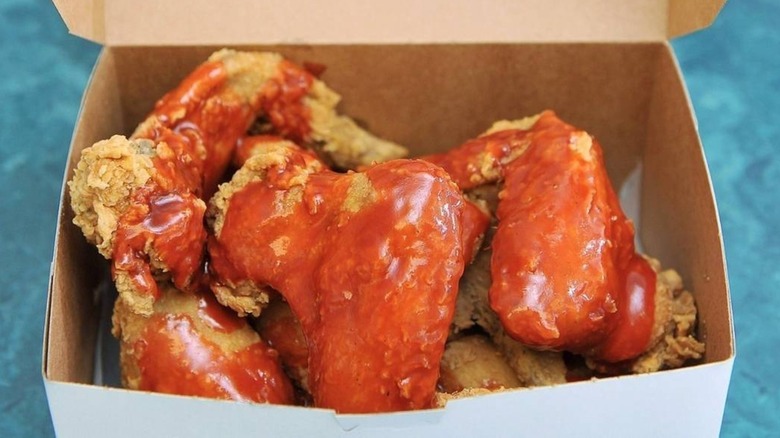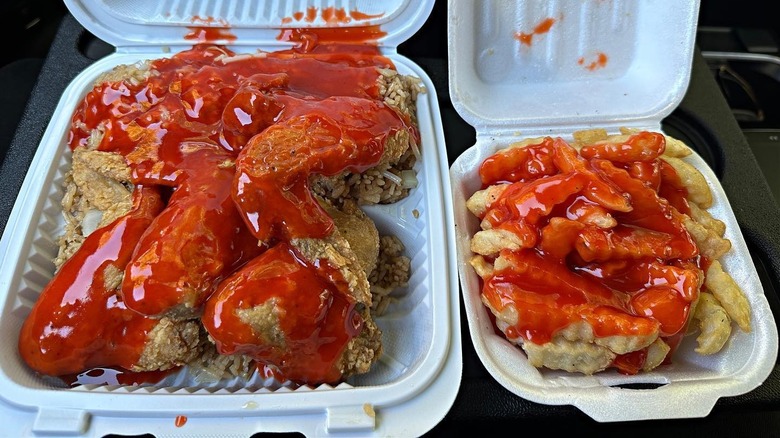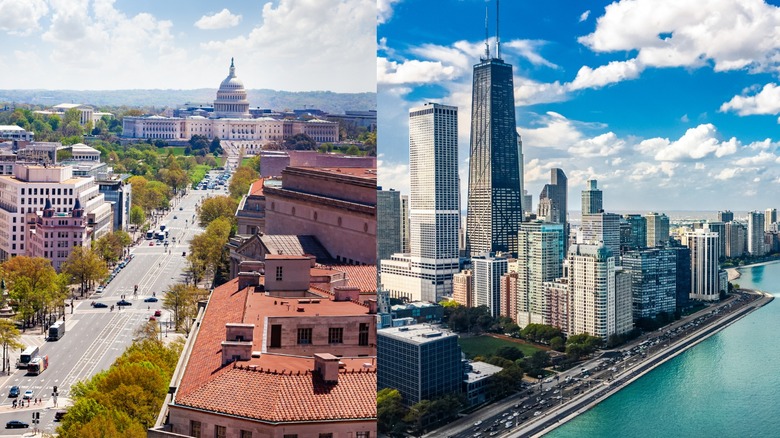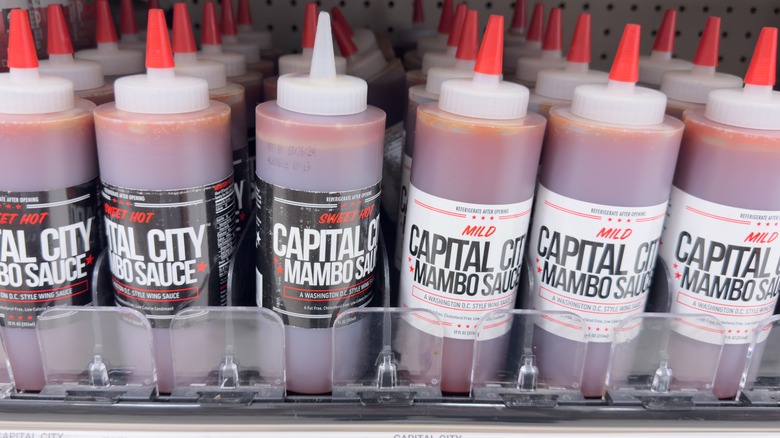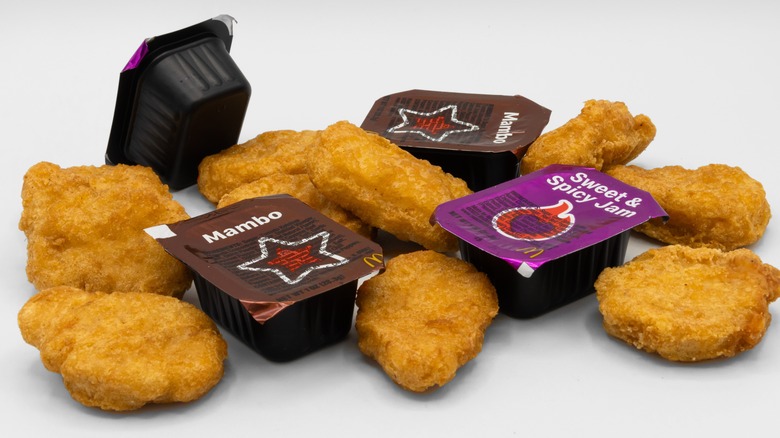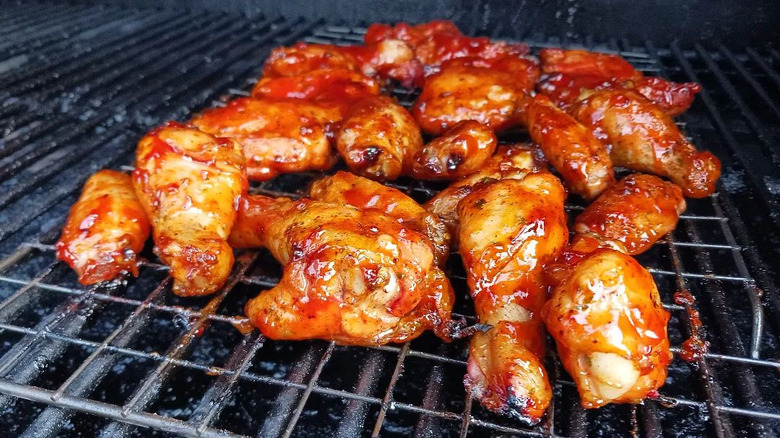Mambo Sauce Is Washington DC's Greatest Culinary Treasure
Washington D.C. holds an incredibly prominent role in the public eye, yet the city's culinary scene is often overlooked amidst the crowded Northeast foodscape that includes New York pizza, Philadelphia cheesesteaks, and New England clam chowder, among other world-renowned dishes.
It's a shame because D.C. boasts a rich culinary legacy, much of it born from the city's prominent Black and Southeast Asian communities. There are Chesapeake Bay blue crabs, jumbo-slice pizza, and the half-smoke, a unique regional hot dog that features a spiced mixture of beef and pork. All are worthy of note, but ask Washingtonians to name the city's most iconic food, and they'll all say the same thing: mambo sauce.
HuffPost explains that the condiment, also known as mumbo sauce, is a staple at Chinese restaurants and fried chicken takeout spots across the District of Columbia. Most places make their mambo sauce in-house, so it can vary depending on where you eat. It ranges from bright orange to dark red, like ketchup but a shade less viscous. The closest thing to compare it to flavor-wise would be Chinese sweet-and-sour sauce — it is sweet, spicy, and tangy all at once.
The exact origin of mambo sauce is hotly debated, but for Washingtonians, it is more than a condiment, it's a cultural artifact. People have powerful opinions about it, from how to make it and how to eat it to what to call it. People have even gone to court over the sauce's name. So what makes mambo sauce worth so much hype?
What is mambo sauce made from?
There is no universally recognized recipe for mambo sauce. Every D.C. eatery that serves it puts its own spin on the formula, but mambo sauce likely contains many of the same ingredients that define ketchup and barbecue sauce, specifically, tomato paste, sugar, and white vinegar. Some people actually use ketchup itself as the base, but it's the extra additions that make mambo sauce distinct.
Epicurious says that Mambo sauce is flavored with a diverse array of ingredients that typically include pineapple juice, soy sauce, powdered ginger, and hot sauce. When everything comes together, you get all five flavors represented in the sauce. You have sweetness from the sugar and pineapple juice. That juice, along with the vinegar, also contributes an acidic tang. Soy sauce provides saltiness and umami, and the ginger powder adds the subtlest touch of bitterness. Add to that the spicy kick of hot sauce, and you've got every experience your taste buds can have combined into one single food.
Where did mambo sauce originate?
The origin of mambo sauce is hotly contested, and the definitive answer may never be clear, even though it appears to be a relatively recent invention. Mambo sauce first caught on sometime around the late-1950s or early-1960s. Its invention has been linked to multiple businesses, but according to Capital City, the name most often thrown about is that of Wings 'N Things, a Black-owned fried chicken restaurant that once stood on 7th Avenue and Florida Avenue NW. It became wildly popular amongst locals, and soon, nearby restaurants started making their own versions, particularly Chinese carryout spots. Mambo sauce also developed close ties to the city's Go-go music scene, a unique regional sound that incorporates elements of R&B and hip-hop. Chicken wings with mambo sauce became a classic post-nightclub meal.
As much as this will pain Washingtonians to hear, there is strong evidence to suggest that mambo sauce actually originated in Chicago. In 1957, Argia B. Collins, owner of Argia B's Bar-B-Q on the city's South Side, invented a spicy, tangy condiment he called "Argia B.'s Mumbo Bar-B-Que Sauce." The following year, he began bottling the sauce in partnership with Select Brands, who secured a trademark for the name "Mumbo Sauce" says the Chicago Tribune. This trademark status seems to have gone unnoticed in Washington D.C., that is until two companies went to court over it.
Is it mambo sauce or mumbo sauce?
Mambo sauce goes by other names, including mombo sauce and mumba sauce, but the one you'll hear the most around D.C. is mumbo sauce. Where this name came from is a mystery. Some say the sauce was invented by a cook named Lorenzo Johnson, and that when diners asked him what he called the creation, he would simply mumble under his breath. The name "mumble sauce" became mumbo sauce.
But what about Argia B. Collins and Select Brands, who patented the name mumbo sauce in 1958? They would strongly object to the Lorenzo Johnson theory, and in fact, Select Brands has shown that it will fight for the mumbo sauce name. Salon explains that in 2011, D.C. entrepreneur Arsha Jones founded Capital City Mumbo Sauce. Her recipe was such a hit that it turned Capital City into a multi-million dollar business, scoring deals with major retailers like Target and Walmart, but she couldn't legally call her product mumbo sauce as long as Select Brands still held the trademark,
Jones filed a petition to cancel Select Brands' trademark, arguing that "mumbo sauce" was so common that it should be reclassified as a generic term. There is precedent for this; "thermos," "zipper," and "aspirin" were all registered trademarks once. This time, however, the courts wouldn't budge, ruling that Select Brands firmly owned the name mumbo sauce. Jones renamed her brand Capital City Mambo Sauce, and other commercial versions of the sauce also use mambo instead of mumbo.
Where to get mambo sauce
If you're in Washington D.C., you already know the answer to this question: any self-respecting takeout spot in the District is going to have its own mumbo sauce, but for those outside the city, it's a bit trickier. This is one of the more regionally-exclusive items in American cuisine. There are a number of recipes for mambo sauce online, so you can try making your own, but if you want to get it straight from the experts, you're still in luck. Brands like Capital City Mambo Sauce now allow you to buy it online and have it shipped straight to you.
In October 2023, mambo sauce took another step into the national spotlight when McDonald's released its own version. Flavor-wise, it's essentially a spicier, tangier version of their barbecue sauce. The recipe was developed in consultation with D.C. chef Jerome Grant and accompanied by a short documentary on mambo sauce's history.
How to use mambo sauce
There aren't too many rules governing the use of mambo sauce, as its versatility is perhaps its strongest suit. It can be used in any instance where you might use ketchup or sweet-and-sour sauce, such as dipping sauce for french fries or spring rolls. In all honesty, you could put this stuff on just about any deep-fried item and it would taste incredible. It's also a popular partner for BBQ food, and can even be used as a marinade, which is particularly popular with the Chicago version.
If you're going to give mumbo sauce the respect it deserves, you really need to douse, not dip. If you order mumbo sauce at one of Washington D.C.'s many fried chicken carryouts, it's going to come on top of the chicken, not on the side, and locals will fiercely defend this practice. As Jermaine Smith, a D.C. chef interviewed by McDonald's for their mambo documentary put it, "You either want it on the chicken or you don't," and trust us, you definitely want it on the chicken.
